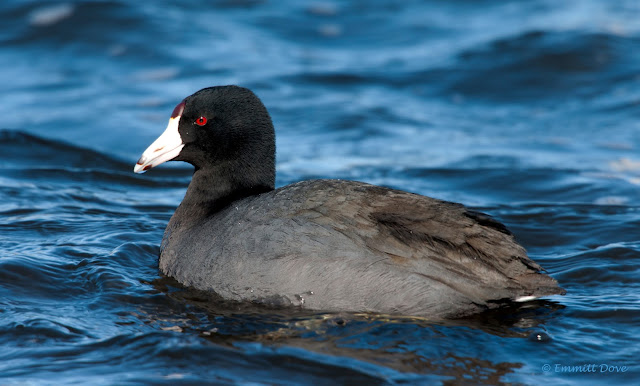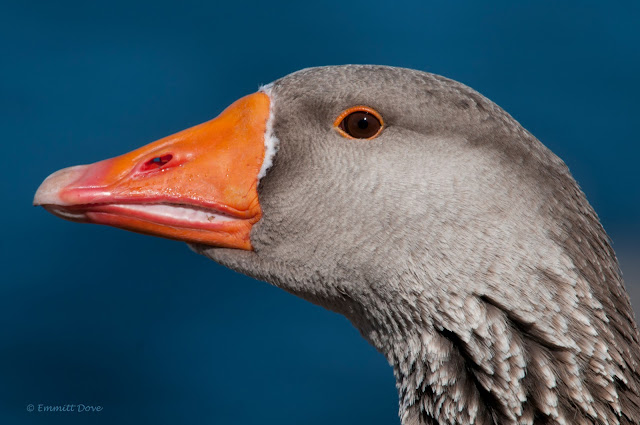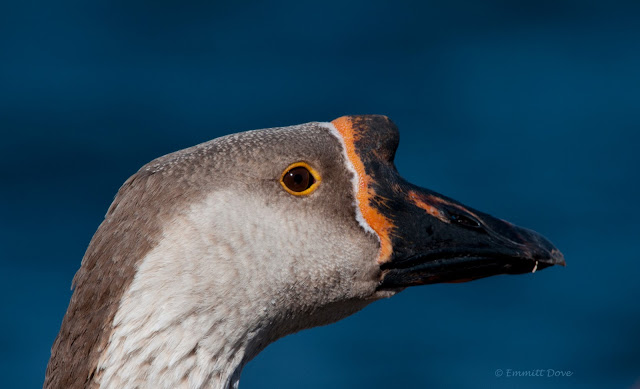I have no photos today, but it isn't for lack of trying. The morning was gray and drizzly, making for lousy conditions.
But, the good news is that just in the past two to three days we've seen redwing blackbirds arriving in numbers. Today I saw cowbirds and grackles among the redwings. And, the hooded mergansers are getting real frisky.
I do hope to be able to capture some images of this behavior. The males puff up their hoods and swim around, then rear their heads back and even rise up out of the water a bit, posturing so as to tower over the rivals. They chase each other all over the pond.
Meanwhile, the females seem to enjoy slapping the water with their wings, darting back and forth, almost as if they are competing with each other, or perhaps just trying to get the males' attention.
2013/02/28
2013/02/25
Great Blue Heron Again
This bird has been around all winter. At times he is very skittish, but today was posing for over a half hour. He was especially resplendent in his breeding plumage, most likely eagerly awaiting the return of his fellow Great Blues that migrated.
2013/02/18
Not All Birds Are Beautiful, But the Head Shot Still Works!
Many birds, mostly among the smaller ones, can be classified as "cute." For many others the term "beautiful" would be more appropriate, while "graceful" applies to still many more.
Some, however, lack those certain qualities that evoke such reactions in we humans. Take, for instance, the American Coot:
I don't think this bird will be found on many people's list of cute, beautiful or graceful birds. Still, for me the combination of the black feathers, the red eye and the reflective blue water makes for an attractive image.
The above photo was taken on a reservoir where a goodly number of hybrid geese reside. Here are some selected head shots of these geese, illustrating the variety to be found and, in my opinion, each containing some elements of beauty.
Two other birds that could be classified among the less attractive are wild turkeys and vultures. (I would also include condors, but we don't have them here in the Eastern US.) For some reason I have yet to get good shots of either of those. I've had opportunities with wild turkeys, but either conditions were poor or the photographer wasn't up to the task.
I had one opportunity with a turkey vulture which was attempting to eat a snake that had been run over by a car. Just as I was prepared to shoot, a bicyclist came along and spooked the bird.
Many people view gulls as pests. Others actively feed them. In their feeding habits, gulls aren't far from crows and vultures. Still, they can make for a good head shot.
I freely admit to enjoying getting good head shots of birds (and other wildlife, for that matter) in part because it requires getting closer to the subject than might otherwise be the case. Gulls, however, make it just too easy.
Some, however, lack those certain qualities that evoke such reactions in we humans. Take, for instance, the American Coot:
I don't think this bird will be found on many people's list of cute, beautiful or graceful birds. Still, for me the combination of the black feathers, the red eye and the reflective blue water makes for an attractive image.
The above photo was taken on a reservoir where a goodly number of hybrid geese reside. Here are some selected head shots of these geese, illustrating the variety to be found and, in my opinion, each containing some elements of beauty.
Two other birds that could be classified among the less attractive are wild turkeys and vultures. (I would also include condors, but we don't have them here in the Eastern US.) For some reason I have yet to get good shots of either of those. I've had opportunities with wild turkeys, but either conditions were poor or the photographer wasn't up to the task.
I had one opportunity with a turkey vulture which was attempting to eat a snake that had been run over by a car. Just as I was prepared to shoot, a bicyclist came along and spooked the bird.
Many people view gulls as pests. Others actively feed them. In their feeding habits, gulls aren't far from crows and vultures. Still, they can make for a good head shot.
I freely admit to enjoying getting good head shots of birds (and other wildlife, for that matter) in part because it requires getting closer to the subject than might otherwise be the case. Gulls, however, make it just too easy.
2013/02/16
Other Winter Birds
While I have been focused on waterfowl lately, there are other birds to be photographed. I reached back to last winter's archive for these Cardinals.
This is a Tufted Titmouse:
And finally, a Black-Capped Chickadee:
This is a Tufted Titmouse:
And finally, a Black-Capped Chickadee:
2013/02/15
Opening in the Ice
As I have noted previously, this time of year the local lakes and ponds are mostly frozen over. Where water flows an opening in the ice may be maintained. This is the case at McKenzie Reservoir in Wallingford, CT, where a road bisects the body of water.
Today I spent nearly an hour photographing one Ring-Necked Duck and one Hooded Merganser at this hole. After over 600 shots I had to just leave, even though the birds were continuing to make themselves available.
These are the best of the shots obtained.
And, for your Daily Merganser, I give you a female Common from the same hole. She decided to vacate shortly after I arrived.
Today I spent nearly an hour photographing one Ring-Necked Duck and one Hooded Merganser at this hole. After over 600 shots I had to just leave, even though the birds were continuing to make themselves available.
These are the best of the shots obtained.
And, for your Daily Merganser, I give you a female Common from the same hole. She decided to vacate shortly after I arrived.
2013/02/14
Ring-Necked Duck
In an earlier post I mused over the name "Ring-Necked" when there is no apparent ring on the duck's neck. This photo captures the hint of a ring that is the genesis of the name.
Here the "ring" can be seen as a reddish spot on the front of the neck. But what caught my eye here are the reflections - the forest green and olive of the evergreen trees in the background reflected in the gently-undulating waves of the pond, and the blue of the sky seen in the duck's bow wave and wake.
Your daily Merganser is a Red-Breasted.
Here the "ring" can be seen as a reddish spot on the front of the neck. But what caught my eye here are the reflections - the forest green and olive of the evergreen trees in the background reflected in the gently-undulating waves of the pond, and the blue of the sky seen in the duck's bow wave and wake.
Your daily Merganser is a Red-Breasted.
2013/02/13
Your Daily Merganser
I was quite fortunate today (2013-02-12) to catch this Hooded Merganser off-guard. Persistence pays off! This photo is not cropped or retouched in any way.
Nikon D300S, AF-S VR Zoom-Nikkor 200-400mm f/4G IF-ED, TC14EII, exposure 1/400 at f/8.
Nikon D300S, AF-S VR Zoom-Nikkor 200-400mm f/4G IF-ED, TC14EII, exposure 1/400 at f/8.
2013/02/12
And a Fog Settled In ...
After the blizzard 2-3 days ago, today we had not only a warming trend but rain to boot. In the afternoon, as the rain slacked, a fog settled in. What an opportunity!
This tree sits in the middle of an open field. The fog offered the opportunity to isolate it against the background.
This island is surrounded by water in an estuary. In the summer and early fall it can be seen loaded with Snowy Egrets and Great Egrets roosting in the trees.
This Great Blue Heron, having stayed for the winter, is desperately seeking sustenance.
A dirt road in summer is covered with snow as it wends its way past a small pond and a rocky outcrop.
What appears to be a simple dirt road through the forest is actually an active railroad bed used by a local trap rock quarry to move its product to either the main Amtrak corridor between New Haven and Boston, or to awaiting barges at a nearby terminal.
During the warmer weather these pilings anchor the floating walkways for a boat club in Stony Creek, CT. Now, a lone gull inhabits the scene.
This tree sits in the middle of an open field. The fog offered the opportunity to isolate it against the background.
This island is surrounded by water in an estuary. In the summer and early fall it can be seen loaded with Snowy Egrets and Great Egrets roosting in the trees.
This Great Blue Heron, having stayed for the winter, is desperately seeking sustenance.
A dirt road in summer is covered with snow as it wends its way past a small pond and a rocky outcrop.
What appears to be a simple dirt road through the forest is actually an active railroad bed used by a local trap rock quarry to move its product to either the main Amtrak corridor between New Haven and Boston, or to awaiting barges at a nearby terminal.
During the warmer weather these pilings anchor the floating walkways for a boat club in Stony Creek, CT. Now, a lone gull inhabits the scene.
2013/02/11
Herons and Egrets
The past few days I have been preoccupied with the blizzard that hit New England. We received around 34" - 36" here. That made for a lot of shoveling out and impassable roads. Additionally, the birds have been scarce in the wake of the storm. Accordingly, I offer a few shots from mid-2012 with an emphasis on herons and egrets.
This bird, labeled by some as a suspected hybrid, probably between a Little Blue Heron and a Tri-Color Heron, was spotted around Hammonasset State Park for several weeks during the mid-to-late summer.
There was some disagreement as to whether this was in fact a hybrid, or merely an immature Little Blue, or a true Tri-Color Heron. Below is a transitional Little Blue for contrast. (Little Blues are all white as young and gradually change.)
Note the particular distinctions from the "hybrid" above, especially the yellow at the root of the beak of the "hybrid." While Juvenile Little Blues may exhibit some yellow coloration, it is not nearly as distinct as seen on the "hybrid" above.
Here is a shot of three different birds - a Great Egret (the large one), a Snowy Egret (the mid-sized one), and a juvenile Little Blue Heron.
This next bird is a Tri-Color Heron.
Note the prominent yellow at the root of the beak. However, the yellow legs are brighter than on the "hybrid" above. Also, note the underside of the wings and the body on the "hybrid" - other images of Tri-Colors show a more uniform white rather than the mottled coloration on the hybrid, which more closely resembles a transitional Little Blue. But the fact that this image was taken roughly a month after the "hybrid" images indicates this may in fact be the same bird farther along in the maturation process.
Still, I am no expert, and it is quite possible that the "hybrid" above is nothing more than an immature Tri-Color. Here is an image of a Tri-Color from the Yucatan that is exceptionally close to the "hybrid" above.
Here are some shots of a mature Little Blue Heron.
We conclude with some Snowy Egrets ...
... and a Great Egret.
Hybrid, or Tri-Color Heron?
This bird, labeled by some as a suspected hybrid, probably between a Little Blue Heron and a Tri-Color Heron, was spotted around Hammonasset State Park for several weeks during the mid-to-late summer.
There was some disagreement as to whether this was in fact a hybrid, or merely an immature Little Blue, or a true Tri-Color Heron. Below is a transitional Little Blue for contrast. (Little Blues are all white as young and gradually change.)
Note the particular distinctions from the "hybrid" above, especially the yellow at the root of the beak of the "hybrid." While Juvenile Little Blues may exhibit some yellow coloration, it is not nearly as distinct as seen on the "hybrid" above.
Here is a shot of three different birds - a Great Egret (the large one), a Snowy Egret (the mid-sized one), and a juvenile Little Blue Heron.
This next bird is a Tri-Color Heron.
Note the prominent yellow at the root of the beak. However, the yellow legs are brighter than on the "hybrid" above. Also, note the underside of the wings and the body on the "hybrid" - other images of Tri-Colors show a more uniform white rather than the mottled coloration on the hybrid, which more closely resembles a transitional Little Blue. But the fact that this image was taken roughly a month after the "hybrid" images indicates this may in fact be the same bird farther along in the maturation process.
Still, I am no expert, and it is quite possible that the "hybrid" above is nothing more than an immature Tri-Color. Here is an image of a Tri-Color from the Yucatan that is exceptionally close to the "hybrid" above.
Here are some shots of a mature Little Blue Heron.
We conclude with some Snowy Egrets ...
... and a Great Egret.
2013/02/08
Signs, Not Necessarily of the Times
As I have traveled around the country I have encountered signs that, perhaps in context were meaningful, but out of context were puzzling or amusing. I am certain that once the teardrop is complete and I embark upon my travels I will encounter even more of them.
So, to get a head start, here I present some of them.
If you need a divorce attorney, try these guys; I'm sure they'll work for you:
Unclear on which end is up?
Moon or Beaver?
Great advertising!
On duty.
Reminds me of a sign in Falmouth, MA (on Cape Cod) reading "Don't even THINK of parking here."
Speaking of that:
Don't even THINK of flying here!
So, to get a head start, here I present some of them.
If you need a divorce attorney, try these guys; I'm sure they'll work for you:
Unclear on which end is up?
Moon or Beaver?
Great advertising!
On duty.
Reminds me of a sign in Falmouth, MA (on Cape Cod) reading "Don't even THINK of parking here."
Speaking of that:
2013/02/07
Great Blue Heron
Today's feature is a Great Blue Heron, hunkered against the chill.
And we have a female Hooded for your daily merganser.
And we have a female Hooded for your daily merganser.
2013/02/06
Ring-necked Ducks
One of the great things about winter is the birds it brings. Another is when the ice constrains divers and dabblers in a small area. What is really great is when those constraining areas are accessible to the glass on your camera.
Today, it was the ice on McKenzie Reservoir in Wallingford, CT, that brought the Ring-necked Ducks within reach. Ringnecks are normally more shy even than the mergansers, swimming away at the most remote approach. Thus, the constraining ice is most helpful to the observer.
The first thing I notice about ringnecks is that they really don't appear to have rings around their necks. How odd! But, they do have a white, blue and black beak that is distinctive, and yellow eyes that pop against the purplish black of their heads.
My apologies for not having a Daily Merganser today.
Today, it was the ice on McKenzie Reservoir in Wallingford, CT, that brought the Ring-necked Ducks within reach. Ringnecks are normally more shy even than the mergansers, swimming away at the most remote approach. Thus, the constraining ice is most helpful to the observer.
The first thing I notice about ringnecks is that they really don't appear to have rings around their necks. How odd! But, they do have a white, blue and black beak that is distinctive, and yellow eyes that pop against the purplish black of their heads.
My apologies for not having a Daily Merganser today.
Subscribe to:
Posts (Atom)






















































